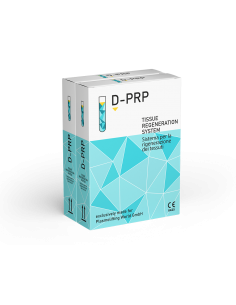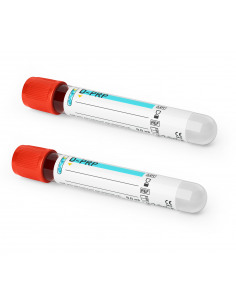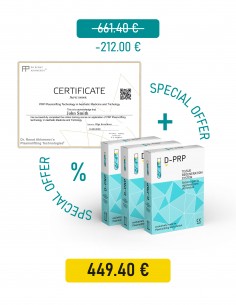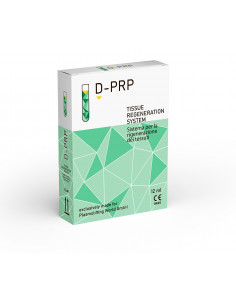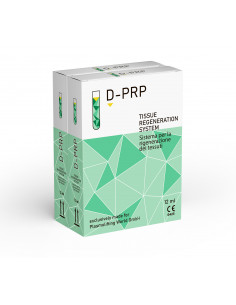Plasmolifting PRP Tubes
- These PRP tubes have already been used by more than 600,000 doctors and applied for more than 10,000,000 treatments;
- We deliver our products worldwide;
- The dispatch takes place as soon as possible or on the same or next working day after payment receipt;
- Your personal account manager will monitor the delivery process for you, inform you about various offers and new products and will be happy to answer all your questions!
PRP tubes – what's that good for?
Our website offers, among other things, the so-called PRP tubes for the production of platelet-rich plasma (PRP). This is our company's core product, which has already been successfully used by thousands of physicians worldwide for many therapeutic purposes. With this contribution we would like to give our customers a brief and concise overview of this product and its constantly growing application possibilities.
How does PRP therapy work?
PRP is used for therapeutic purposes for the treatment of a long list of ailments and diseases as main or adjuvant therapy. In PRP therapy, also called autologous blood therapy, platelet-rich plasma is produced from autologous blood using PRP tubes and is then applied to the patient's area to be treated, e.g., by means of an injection. Platelets are the main reason for the therapeutic effectiveness of PRR, since they release over 30 different growth factors and other regulatory proteins in the first few minutes in a damaged tissue, thus triggering a cascade of events such as recruitment of immune cells, activation of stem cells, tissue regeneration, vascularization, collagen synthesis, bone mineralization etc. It is exactly the effects that are stimulated for therapeutic purposes when using PRP. This therapy thus makes use of the patient's own healing powers.
Advantages and adverse effects of treatment with autologous plasma
PRP therapy is currently experiencing a tremendous boom: According to the American Society of Plastic Surgeons, the number of PRP treatments in the US has increased by more than 130% since 2015 to 2020. The main reason for this is a lot of benefits that this therapy implies:
• Cost Efficiency: The price-performance ratio of the treatment can be rated as excellent.
• Uncomplicated and simple implementation: The treatment can be performed on an outpatient basis within a quarter of an hour.
• High willingness of patients to consent: It is painless, requires no surgical intervention and therefore no long downtimes.
Excellent tolerability and extensive freedom from adverse effects: Since these are the body's own substances, allergies, adverse effects, complications and other risks are largely excluded. This fact becomes particularly interesting for aesthetic medicine, where PRP or products developed on the basis of it can become a natural alternative to many synthetic filers due to their high biocompatibility.
• Accelerated healing and pain alleviation: Activated regeneration processes usually lead to rapid pain alleviation and acceleration of healing processes.
• Sustainability of therapy effectiveness: The healing effect of the therapy is natural and therefore sustainable.
• Ideal adjuvant therapy: This therapy can be easily integrated into many treatment strategies, especially due to its simplicity, cost-effectiveness and naturalness.
How is platelet-rich plasma produced using PRP tubes?
The PRP production should be carried out by trained medical personnel. In the process, platelets are isolated and concentrated, while unwanted components such as red blood cells and leukocytes are removed. The procedure begins with taking of autologous venous blood sample (autologous means from the patient himself). Normally, only 10-15 ml of peripheral whole blood is sufficient to produce an adequate amount of the preparation for one treatment. The blood is cell-friendly taken directly into the PRP tube, which is inserted into the so-called Vacutainer blood collection system for this purpose. The tubes are then centrifuged for 3-5 minutes.
In addition to an anticoagulant to prevent the formation of blood clots, the PRP tubes contain a special, polymeric, thixotropic gel whose composition is patented. This separation gel is the key element of this technology. Centrifugation separates the blood into fractions according to their specific gravity, while the separation gel forms a safe barrier that prevents the mixing of the relatively heavy downwardly pressed fraction of erythrocytes and leukocytes from the therapeutically relevant supernatant containing plasma, platelets, various nutrients and bioactive molecules. This sterile and highly effective substance is suitable for many therapeutic applications and can be injected subcutaneously, for example.
Where are PRP tubes used in medicine?
Thanks in particular to its regenerative effect, but not least also to its cost efficiency, excellent tolerability and other advantages, this therapy has amazing healing possibilities and already today a very wide range of medical applications, whose future expansion is only to be expected.
Especially in aesthetic medicine, this therapy triggered a real boom with its anti-aging potential. Vampire lifting, a new method for facial skin rejuvenation, which was popularized by Hollywood divas, is today celebrating its rapid entry in beauty salons worldwide. A great potential for hair transplants and autologous fat grafting is clearly documented. But this rejuvenating effect also helps to cure many other skin imperfections such as scars, wrinkles, acne, skin ulcers.
Orthopedics and sports medicine are two areas where PRP therapy has been established since the late 1990s and where it is now comprehensively used: Bone fractures, joint diseases, arthrosis, arthritis, osteochondrosis, spinal disc herniation, bone necrosis, sports injuries of tendons, ligaments, cartilage, etc.
Although autologous blood products have been used in the field of dental, oral and maxillofacial surgery since the 1960s, PRP therapy has only been experiencing its true heyday in the field of dentistry for a few years, thanks mainly to modern, fast and cost-effective PRP production processes. The indications for PRP use are the same as in orthopedics: pain alleviation, accelerated tissue regeneration, shortened healing period, activation of collagen synthesis and bone mineralization. Consequently, the application goals in the dental field are increasing: tooth extraction, treatment of periodontal bone pockets, bone grafting, alveolar healing, augmentation of the sinuses floor (sinus lift), ridge augmentation, closure of lips and palate defects, cyst removal, etc.
The age of mothers at birth of their children has risen dramatically in the last 50 years and has already exceeded the 30-year mark in many European countries. Consequently, the demand for anti-aging methods in reproductive medicine is continuously increasing. In the case of the so-called vaginal rejuvenation, PRP is injected into the vaginal areas to be treated, whereby many symptoms such as a disturbed menstrual cycle, damaged mucous membranes, skin cracks and injuries in the vagina can be treated with a high success rate. Positive therapeutic effects can also be achieved with PRP application in the form of adjuvant therapy in many gynecological and urological diseases and surgical interventions.
Orthopedics, oral surgery, trichology, sports medicine, gynecology, urology, cardiac surgery, ophthalmology, aesthetic medicine, wound treatment, infection control… This list of medical fields for PRP application can only be expanded and detailed in the future.

